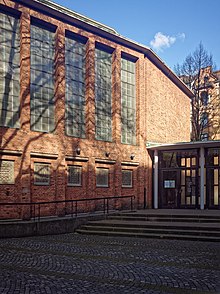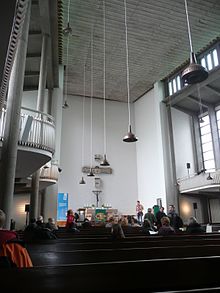Holy Trinity Church (Hamburg-St. Georg)
The Holy Trinity Church , often also called St. George's Church, is located in the Hamburg district of St. Georg not far from the Lange Reihe , very close to Hamburg's main train station and, next to the Church of the Redeemer in Borgfelde, is one of the two preaching sites of the evangelical- Lutheran parish of St. Georg-Borgfelde.
history
Origins
The area of today's St. Georg originally belonged to the parish of Hamburg's main church St. Jacobi since the Middle Ages . The existence of a chapel of the infirmary in front of the city, the St. George's Hospital, was first recorded in 1220 . At that time Albrecht von Orlamünde made a foundation for the hospital that had existed for several decades. This first chapel was probably made of field stones and was replaced by a brick building in the 14th century . In 1452 the chapel was enlarged by donations to a church with a tower and in the following years it was equipped with several depictions of St. George and an organ.
After the Hamburg ramparts were built in 1629, the chapel initially served as a parish church for the areas outside the walls, but soon proved to be too small for the growing population. The medieval church was therefore expanded several times until it could hold 1,200 people in 1655.
In 1743 the old church was so dilapidated that it was demolished. Under the direction of Johann Leonhard Prey one was baroque new building erected. For the inauguration on October 26, 1747, the oratorio Heilig, Heilig, Heilig ist Gott is performed by Georg Philipp Telemann .
This church was almost completely destroyed during the bombing raids in July 1943 .
Reconstruction in 1957
Today's church was rebuilt in 1957 as an inner-city concert church based on a design by the architect Heinz Graaf ; it is considered a particularly successful example of the sacred architecture of the 1950s. The reconstruction of the tower, which was destroyed except for a stump, according to the original plans by Johann Leonhard Prey, was completed on January 21, 1962. The nave is not in one axis with the tower and is only connected to it by a glazed corridor. It again received an elegant attachment with a delicate tip and thus its original height of 66.6 m. A preserved baroque portal was added to the new building on the north side of the church.
Outside there is a plaque commemorating the work of Pastor JWRautenberg (1820–1865). In addition to the tower, there is also the equestrian statue of St. George created by Gerhard Marcks in 1958, which shows him slaying a dragon and which has become a landmark of the district.
Furnishing
The entrance to the church is on the side. The church offers 700 seats and excellent acoustics. The chancel, which is lit from the side, is determined by the contrast between light travertine and dark dolomite . The 20 large windows, which were renewed in 2003 , were designed by the glass artist Jochem Poensgen .
References to the Trinity
The number three in the representations and the equipment indicates the trinity. For example pulpit - altar - baptism, number of windows, skylights and galleries. Above the altar is a representation of the divine trinity by Karl Knappe : the hands of God at the creation of the world, Christ with his disciples at the Lord's Supper, the dove as a symbol of the Holy Spirit, the connection between God and man.
The bible on the altar is a gift from the incumbent Federal President Theodor Heuss in 1957 with his personal dedication.
Christian symbols
The crucifix was created by Jürgen Weber . The colored windows with their economical variations of red and white come from the workshop of Gerhard Hausmann , as well as the colored windows with Christian symbols under the organ. In the middle the Chi-Rho (Christ monogram), to the right and left of it the Alpha and Omega, on the left outside the ear and on the right outside the vine.
chapel
The former entrance hall on the first floor of the tower is now a chapel. This is where the crucifixion group from the end of the 15th century found its place, which originally stood in the open air in front of the church. It is one of the oldest works of art in Hamburg: Jesus on the cross, his mother Mary and one of his disciples, Johannes , mourning next to him, the criminals crucified with Jesus on his left and right. This group originally formed the last station of a way of the cross that began at the Mariendom .
Also noteworthy are the handles of the church doors by Karl Heinz Engelin with the symbols of the evangelists : on the door to the church from the pergola the bull for Luke and the human face for Matthew , on the baroque portal on the north side the lion for Markus and the eagle for John . At the entrance to the tower chapel Jonah and the whale.
Bells
The church has a four-part ring made of bronze bells and two bell bells . A chiming bell and a large bell from 1797 date from the time before the church was destroyed. All other bells were made by the Rincker bell foundry from 1959 to 1961 .
organ
Before 1943
The old organ of the Dreieinigkeitskirche (III / 62) was built by Johann Dietrich Busch in 1744 , in 1943 it was destroyed in the Hamburg firestorm .
The major C sharp has always been missing in the manuals. Organ builder Götzel later added the C sharp to all pedal parts. The trumpet 4 'in the main work had a strange arrangement. In the two low octaves, the register 4' remained in the treble, but it is set as 8 '. 62 registers , 8 bellows , over 3000 pipes . Record of the disposition on the 1st of Advent 1858 according to Theodor Cortum.
|
|
|
|
|||||||||||||||||||||||||||||||||||||||||||||||||||||||||||||||||||||||||||||||||||||||||||||||||||||||||||||||||||||||||||||||||||||||||||||||||||||||||||||||||||||||||||
- Pair : II / P, III / II, II / I
- Playing aids : Calcant, Cymbelstern, Tremulant
After the reconstruction
Today's organ was built in 1959 by the Walcker & Cie. built. The instrument has 36 registers, divided into three manuals and pedal. In 1971 the register action was electrified.
|
|
|
|
||||||||||||||||||||||||||||||||||||||||||||||||||||||||||||||||||||||||||||||||||||||||||||||||||||||||||||||||||||||||||||||
Photographs and map
Coordinates: 53 ° 33 '23 " N , 10 ° 0' 28" E
See also
literature
- Ralf Lange: Architecture in Hamburg . Junius Verlag , Hamburg 2008, ISBN 978-3-88506-586-9 , p. 141 f .
- Gertrud Schiller : Hamburg's new churches 1951–1961 . Ed .: Evangelical Lutheran Church Hamburg. Hans Christians Verlag, Hamburg 1961, p. 46-49, 76 .
- Friedhelm Grundmann, Thomas Helms: When stones preach . Medien Verlag Schubert, Hamburg 1993, ISBN 3-929229-14-5 , p. 55 f., 66 f .
Individual evidence
- ↑ Volker Plagemann: Sunken Church History. The churches and artists of the Middle Ages in Hamburg . Hamburg 1999, p. 144.
- ↑ a b c History of the Dreifaltigkeitskirche
- ^ Adolf Diersen: From the history of the Hammer Dreifaltigkeitskirche , Holzminden 1957, p. 9.
- ↑ Hl. Dreieinigkeitskirche St. Georg (Ed.): Holy Trinity Church St. Georg. Leaflet from around 2015.
- ↑ Entry in the organ database orgbase.nl . Retrieved February 20, 2015.
Web links
- Parish of St. Georg-Borgfelde
- Description on the homepage of the city of Hamburg






